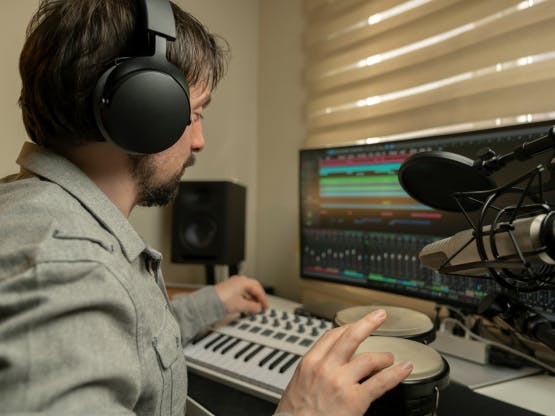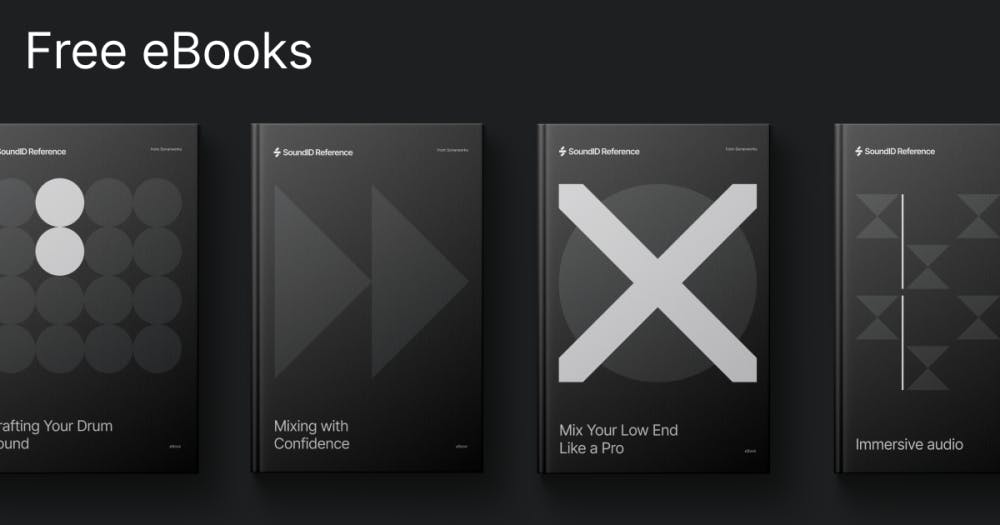Why You Need a Checklist
In 2025, home studios must handle more than just stereo recording. Immersive formats, hybrid workflows, and AI tools have expanded the possibilities and the complexity. Without a structured plan, it’s easy to miss essential gear or skip critical setup steps. A checklist gives you a repeatable framework for consistency, accuracy, and future‑proofing your setup. It also points you to deeper resources on monitor calibration and room treatment when you need them. Let’s dive in!
✅ Download the Printable Checklist
To make setup easier, download a free PDF that lists every item in this article in a simple, tick‑box format. Use it as you assemble or upgrade your studio.
1. Computer & DAW
At the heart of every studio is the computer and DAW. In 2025, though, they’re handling far more than just multitrack recording. Modern workflows rely on both time-based audio (waveforms) and frequency-based audio (spectral data). Machine learning often favors waveforms, while spectral tools power analysis, correction, and creative effects. It’s not about choosing one or the other—they now work together, shaping the way we produce music. To keep up, your workstation needs enough power for large sample libraries, real-time AI plugins, and immersive mix formats, all while staying stable and low-latency. When choosing your setup, think about the following:
- Modern CPU (Apple Silicon M3/M4 or AMD Ryzen class) and 32 GB RAM for large sample libraries and AI plugins.
- Fast SSD storage to handle multitrack projects. Modern DAW sessions with AI plugins, stem exports, and immersive format renders can easily exceed 50GB per project.
- DAW of your choice: Pro Tools, Logic Pro, Ableton Live, Cubase, Reaper, or Studio One. Choose based on immersive format capability and AI plugin compatibility. Pro Tools leads in professional environments, Logic Pro excels for AI integration, while Reaper offers unprecedented customization for computational audio workflows.
- Optimization tip: disable background updates and turn off unnecessary network services to reduce audio latency.
For immersive mixing system requirements and DAW compatibility, see our article about Atmos on a Budget. It describes the minimum hardware needed for Atmos and shows cost‑effective upgrade paths.
2. Audio Interface & Signal Chain
The latest generation of digital audio interfaces, powered by USB4 and Thunderbolt 4, are capable of handling over 64 channels at 192 kHz while maintaining sub-2 ms latency. This leap in performance not only ensures seamless multitrack recording and mixing but also lays the groundwork for real-time AI-driven processing to run in parallel with traditional audio routing – an essential shift for the future of modern music production.
Your interface is the nerve center of your studio, therefore it’s important to look for:
- Stable drivers and low latency (USB4, Thunderbolt 4 or PCIe).
- 48 V phantom power and high‑quality mic preamps.
- Multiple outputs if you plan to expand into multichannel or immersive setups. Twelve to sixteen outputs are ideal for a 7.1.4 Atmos system.
- Sample rates up to 96 kHz, but stability matters more than headline numbers.
See Sonarworks’ guide on audio interface compatibility for a deeper look at recommended brands and setup tips. If you use Universal Audio or Audient hardware, check the posts on real‑time SoundID Reference integration.
3. Studio Monitors
Every monitoring choice—whether it’s acoustic treatment or digital correction—serves one main goal: making sure your mix isn’t locked to the sound of a single pair of speakers. In 2025, the blend of room acoustics and modern processing tools makes it possible to create listening environments where your creative decisions translate reliably across any playback system, from studio monitors to earbuds to club PAs.
Essentially, studio monitors are the windows into your mix. To choose wisely:
- Decide between near‑field, mid‑field, or far‑field monitors based on your room size. Near‑fields work best in small rooms (optimized for 1-3 meter listening distances); mid‑fields offer more bass for medium rooms; current pop and hip-hop frequently contain energy below 40Hz that smaller monitors simply cannot reproduce; far‑fields are for large control rooms and mastering suites.
- Look for a flat frequency response and avoid consumer‑oriented hype. The article Studio Monitors: Everything You Need to Know explains passive, powered, and active designs.
- Follow the equilateral triangle rule for positioning and keep tweeters at ear height.
- For low‑frequency extension, decide whether to buy larger monitors or add a subwoofer. See Do I Need a Subwoofer or Larger Monitors? for guidance.
- Once installed, calibrate your monitors and the room. It’s very important to note that calibration doesn’t replace acoustic treatment, but it complements it.
4. Headphones & Alternative Monitoring
By 2025, headphones are no longer just a backup option for late-night editing, they have become a central tool in professional mixing workflows. Advances in calibration science now allow properly tuned headphones to rival, and in some cases surpass, the consistency of uncalibrated studio monitors. Using minimum-phase filtering, modern calibration preserves both frequency balance and transient detail, ensuring that critical mix decisions hold up across playback systems. In this new landscape, headphones can deliver a level of accuracy and translation that was once the exclusive domain of studio monitors.
- Choose closed‑back headphones for tracking and isolation; open‑back for mixing and critical listening.
- Look for a neutral frequency response, comfortable build, and easy serviceability. For model recommendations, explore Sonarworks’ Best Pro Studio Headphones Guide for 2025 and the review category for specific models (HD650, DT 900 PRO X, MDR‑7506, etc.).
- Calibrate your headphones with SoundID Reference; it aligns their tonal balance with your speakers and offers translation curves.
- To make headphone mixes translate, use crossfeed and reference curves. See the article Mixing with Headphones: Make Mixes Translate on Speakers for workflow tips.
5. Microphones & Preamps
You don’t need dozens of microphones to produce professional results. Start with:
- A dynamic microphone for vocals and instruments in untreated rooms. Dynamic mics are forgiving of room noise and deliver solid results.
- A large‑diaphragm condenser for detailed vocals and acoustic instruments in a treated space.
- Modeling microphones are gaining popularity by offering emulations of vintage mics at a lower price.
If you’re curious about preamps, read Outboard Mic Preamps vs. Interface Preamps to see when an external preamp adds value and Mic Preamps: Are They Really Needed? for a deeper dive.
6. Acoustic Treatment & Calibration
No gear upgrade will fix an untreated room. Proper treatment and calibration are the cornerstones of any studio.
- Bass traps in corners to tame standing waves.
- Broadband absorbers at first reflection points.
- Diffusers in larger rooms to maintain natural ambiance.
- Calibrate your monitors using SoundID Reference. The software compensates for room modes and frequency‑response issues, delivering neutral playback.
- Don’t let anyone tell you that software alone is enough—acoustic treatment and calibration work best together.
The article How to Use SoundID Reference with Different Monitor Types details calibration for near‑, mid‑, and far‑field speakers.
7. Monitoring Accuracy Tools
Beyond flat calibration, modern tools help you preview your mix on various playback systems.
- Virtual monitoring plug‑ins simulate consumer speakers, car stereos, earbuds, and club systems. Use them to spot translation issues before exporting.
- Custom target curves let you personalize the sound of your monitors while keeping translation under control. See What Is Flat Sound and Should I Care? for an explanation of different target curves and how to apply them.
- SoundID Reference’s Translation Check lets you instantly preview how your mix will sound on common playback systems, like laptops, phones, or car stereos, without leaving your calibrated monitoring environment. It helps you catch translation problems early and make adjustments with confidence.
8. Workflow & Ergonomics
A productive studio goes beyond sound.
- Invest in an ergonomic desk and adjustable stands to prevent fatigue.
- Use monitor arms to free desk space.
- Label your cables and keep them organized.
- Implement a backup strategy with both local and cloud storage.
- Use an uninterruptible power supply (UPS) to protect your equipment and recordings.
These changes don’t directly improve sound quality, but they reduce friction and improve long‑term productivity.
9. Emerging Technologies & Trends
2025 brings exciting new tools and challenges:
- AI mixing assistants like LANDR help automate repetitive tasks like vocal comping, noise reduction, and basic balance. They speed up your workflow, but human judgment remains irreplaceable.
- Voice AI tools allow quick voice cloning and creative vocal effects. See Sonarworks’ research on AI‑driven production for insights into the future of AI-produced music.
- Immersive formats like Dolby Atmos and Sony 360 are now mainstream on streaming platforms. They’re worth considering if you produce for film, TV, gaming, or want your music to stand out with spatial mixes that reach wider audiences.
Putting It All Together
A successful 2025 home studio balances accuracy, translation, and adaptability. It’s not about owning the most expensive gear; it’s about making sure every component, from your computer to your speakers, works together in a calibrated, treated environment. Even the best monitors sound poor in the wrong room; precise conversion and DSP are fundamental to digital audio quality. Calibration and proper monitoring translate directly to better mixes.
Use this checklist to build a studio that scales with your creativity. Download the PDF version to keep track of your progress, explore the linked Sonarworks articles for deeper learning, and enjoy a setup that’s ready for whatever the next wave of audio technology brings.
Frequently Asked Questions About Building a 2025 Home Studio
What is the best computer setup for music production in 2025?
A modern Apple Silicon M3/M4 or AMD Ryzen workstation with at least 32 GB RAM and a fast NVMe SSD is considered the new standard. This ensures seamless playback of large sample libraries, stable low-latency AI plugins, and reliable rendering of immersive formats like Atmos.
Do I need Dolby Atmos speaker setup for a home studio in 2025?
Not every producer needs a full Atmos system. If you’re working on music that will be distributed on streaming platforms supporting Atmos, a 7.1.4 system is recommended. Otherwise, calibrated stereo or binaural monitoring still delivers professional results.
Are headphones accurate enough for mixing in 2025?
Yes, especially when calibrated. Advances in headphone correction software like SoundID Reference make headphones a primary mixing tool for many pros. With proper crossfeed and calibration, mixes done on headphones can reliably match speaker playback.
How important is acoustic treatment compared to monitor calibration?
Both are essential; physical treatment reduces destructive reflections and modes, while calibration fine-tunes the playback response. Skipping either one risks mixes that fall apart outside your studio.
Which audio interface should I buy for future-proofing my studio?
Look for interfaces with USB4 or Thunderbolt 4 connectivity, stable drivers, and multiple outputs for immersive or hybrid setups. A minimum of 12–16 outputs supports Atmos expansion, while low-latency monitoring ensures smooth real-time performance with AI-driven tools.
Do I still need outboard gear in a 2025 studio?
Not necessarily. High-quality plugins and modeling microphones can replace much of the outboard rack, though dedicated preamps or compressors can still add character if budget allows.
What’s the biggest mistake new producers make with their home studio setup?
Over-investing in gear while neglecting translation. Without treating and calibrating your monitoring chain, even expensive monitors won’t yield mixes that travel. Finneas has pointed out that his biggest records came from a bedroom, but always with careful attention to monitoring accuracy.
How do I make my studio workflow more efficient?
Use ergonomic furniture, cable labeling, and cloud-based backups to reduce friction. Automation and AI mixing assistants can speed up vocal comping and balancing, but human decision-making remains the gold standard for musicality, therefore trust creators with years of experience like Bobby Owinski.
Discover more tips about building and updating your studio in our blog:
Budget‑Friendly Acoustic Fixes For A Bedroom Studio





